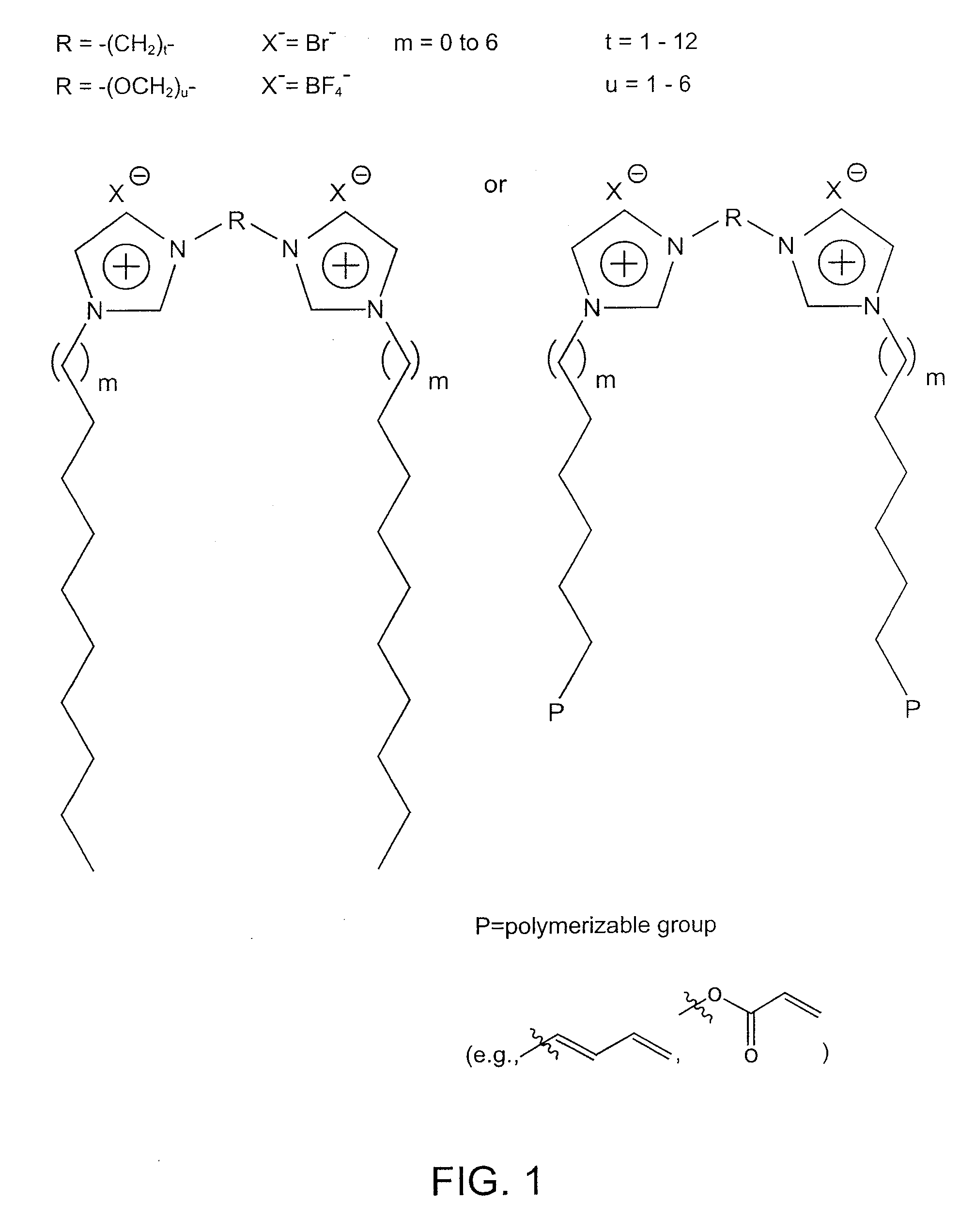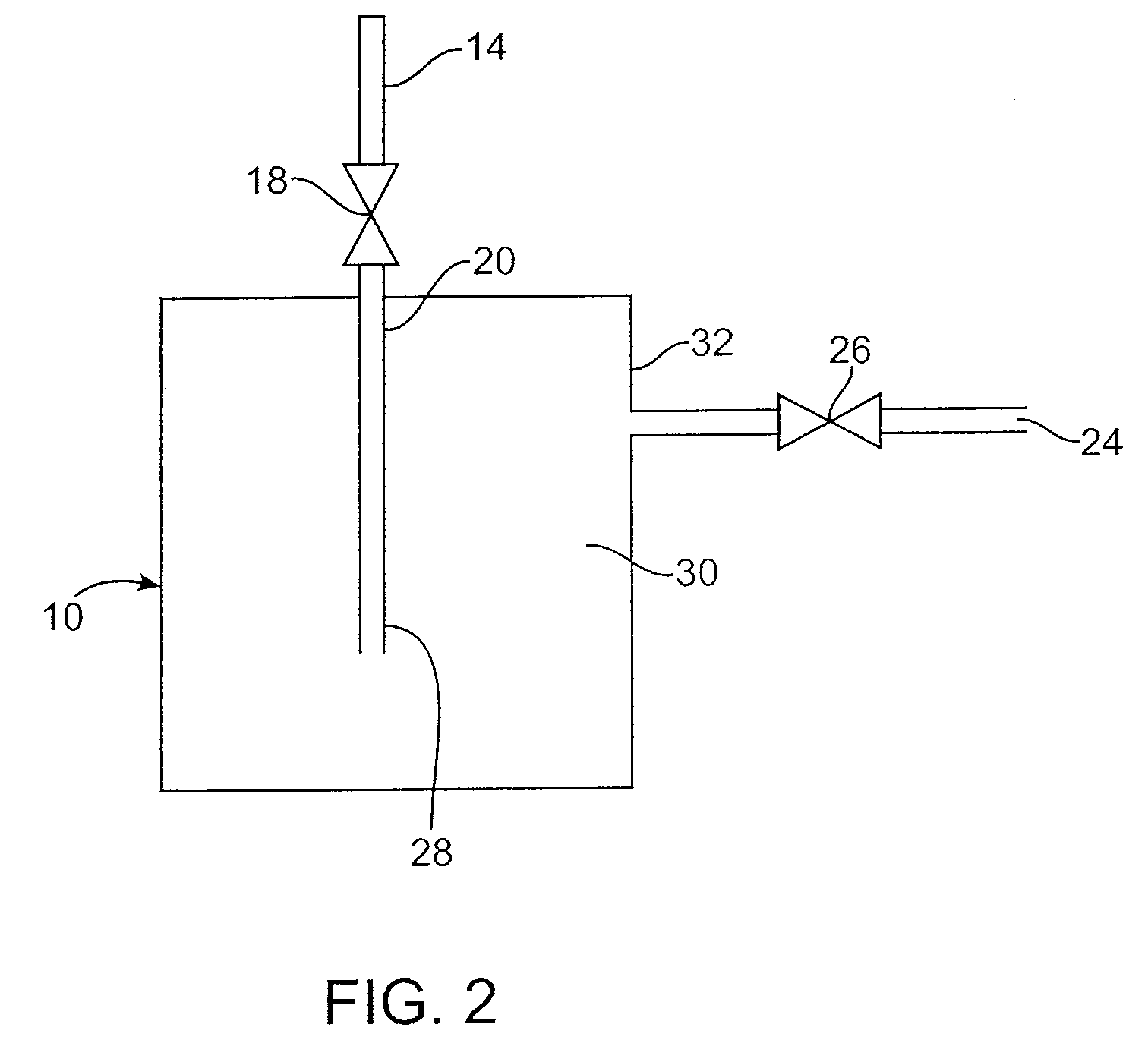Fluid Storage and Purification Method and System
- Summary
- Abstract
- Description
- Claims
- Application Information
AI Technical Summary
Benefits of technology
Problems solved by technology
Method used
Image
Examples
example 1
Storage of a Gas Using Nanocomposite Material in which the Solvent is an Ionic Liquid—BF3 Stored in poly[1,1′-[1,2-ethanediylbis(oxy-2,1-ethanediyl)]-2,2′-undecyl-3,3′-(undecyl-11-acryloyloxy-bisimidazolium di-tetrafluoroborate]; 1-ethyl-3-methylimidazolium tetrafluoroborate
[0106]A stainless steel canister is charged with a known quantity of the nanocomposite material poly(1,1′-[1,2-ethanediylbis(oxy-2,1-ethanediyl)]-2,2′-undecyl-3,3′-(undecyl-11-acryloyloxy)-bisimidazolium di-tetrafluoroborate); 1-ethyl-3-methylimidazolium tetrafluoroborate. The charged canister is thermally controlled by a PID temperature controller or variac with a heating element and a thermocouple. The canister is placed on a gravimetric load cell or weight scale and a pressure gauge is connected to the canister to measure head pressure. This canister is connected to a manifold with vacuum capability and to a gas source. The canister is also connected to an analyzer (such as FT-IR, GC, APIMS, etc.).
[0107]A vacu...
example 2
Storage of a Gas Using Nanocomposite Material in which the Solvent is a Molecular Solvent—BF3 Stored in poly[1,1′-[1,2-ethanediylbis(oxy-2,1-ethanediyl)]-2,2′-undecyl-3,3′-(undecyl-11-acryloyloxy)-bisimidazolium dibromide].H2O
[0110]A stainless steel canister is charged with a known quantity of the nanocomposite material poly[1,1′-[1,2-ethanediylbis(oxy-2,1-ethanediyl)]-2,2′-undecyl-3,3′-(undecyl-11-acryloyloxy)-bisimidazolium dibromide].H2O. The charged canister is thermally controlled by a PID temperature controller or variac with a heating element and a thermocouple. The canister is placed on a gravimetric load cell or weight scale and a pressure gauge is connected to the canister to measure head pressure. This canister is connected to a manifold with vacuum capability and to a gas source. The canister is also connected to an analyzer (such as FT-IR, GC, APIMS, etc.).
[0111]A vacuum bake procedure is conducted on the canister, charged with poly[1,1′-[1,2-ethanediylbis(oxy-2,1-ethan...
example 3
Storage of a Gas Using Nanocomposite Material in which the Solvent is a Mixture of Ionic Liquid and Molecular Solvent—BF3 Stored in poly[1,1′-[1,2-ethanediylbis(oxy-2,1-ethanediyl)]-2,2′-undecyl-3,3′-(undecyl-11-acryloyloxy-bisimidazolium di-bromide]1-ethyl-3-methylimidazolium bromide.H2O
[0114]A stainless steel canister is charged with a known quantity of the nanocomposite material poly[1,1′-[1,2-ethanediylbis(oxy-2,1-ethanediyl)]-2,2′-undecyl-3,3′-(undecyl-11-acryloyloxy)-bisimidazolium di-bromide].1-ethyl-3-methylimidazolium bromide.H2O. The charged canister is thermally controlled by a PID temperature controller or variac with a heating element and a thermocouple. The canister is placed on a gravimetric load cell or weight scale and a pressure gauge is connected to the canister to measure head pressure. This canister is connected to a manifold with vacuum capability and to a gas source. The canister is also connected to an analyzer (such as FT-IR, GC, APIMS, etc.).
[0115]A vacuum ...
PUM
 Login to View More
Login to View More Abstract
Description
Claims
Application Information
 Login to View More
Login to View More - R&D
- Intellectual Property
- Life Sciences
- Materials
- Tech Scout
- Unparalleled Data Quality
- Higher Quality Content
- 60% Fewer Hallucinations
Browse by: Latest US Patents, China's latest patents, Technical Efficacy Thesaurus, Application Domain, Technology Topic, Popular Technical Reports.
© 2025 PatSnap. All rights reserved.Legal|Privacy policy|Modern Slavery Act Transparency Statement|Sitemap|About US| Contact US: help@patsnap.com



